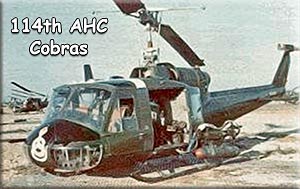

The AH-1 Helicopter Name - Conflict of Tradition?
Michael Peake 2022
Recently, our Centaur webmaster Bruce Powell introduced me to a film segment on Lloyd B. Allred's Centaur My Page triggering an interesting research project. In September 2009, the Sacramento, California native Captain Allred sat for an interview with retired Air Force Chief Master Sergeant Dennis Hunter to record his remembrance of Vietnam service for the Veterans History Project organized by the American Folklife Center of the Library of Congress. Mr. Allred served his first in-country tour in 1966, as 1st Lieutenant piloting a UH-1C “Iroquois” Gunship with D Troop (Air), 3rd Squadron, 4th Cavalry Regiment, 25th Infantry Division; and later in 1968, flying down in the Mekong Delta region as an AH-1G pilot with the 114th Assault Helicopter Company, a unit of the 13th Combat Aviation Battalion, "Shield of the Mekong," that arrived in-country at the end of September 1964.
 In speaking to the history of the 114th (between time hacks 35:08 and 35:39 of the full video), Lloyd Allred recalled the unit's Cobra Platoon, one of the first assault helicopter units in Vietnam whose call-sign, “Vinh Long Cobras,” became synonymous with gunships, resulting in that title "Cobra" being attached to the AH-1G when introduced into the inventory. This nomenclature stood in conflict with a long established Army tradition of naming helicopters in honor of Native American tribes, a practice that actually became an Army regulation in 1969 (AR 70-28 Assigning Popular Names To Major Items Of Equipment), long after the "Cobra" had become combat proven as a superior weapons platform. But this Army tradition of naming U.S. Army helicopters in honor of indigenous peoples, although somewhat foggy in origin, provides one view claiming it began in the mid-1940s, before the Air Force separated from the Army, with the Bell Aircraft Corporation H-13 “Sioux” Light Observation Helicopter that remained in service from 1946 until 1974.
In speaking to the history of the 114th (between time hacks 35:08 and 35:39 of the full video), Lloyd Allred recalled the unit's Cobra Platoon, one of the first assault helicopter units in Vietnam whose call-sign, “Vinh Long Cobras,” became synonymous with gunships, resulting in that title "Cobra" being attached to the AH-1G when introduced into the inventory. This nomenclature stood in conflict with a long established Army tradition of naming helicopters in honor of Native American tribes, a practice that actually became an Army regulation in 1969 (AR 70-28 Assigning Popular Names To Major Items Of Equipment), long after the "Cobra" had become combat proven as a superior weapons platform. But this Army tradition of naming U.S. Army helicopters in honor of indigenous peoples, although somewhat foggy in origin, provides one view claiming it began in the mid-1940s, before the Air Force separated from the Army, with the Bell Aircraft Corporation H-13 “Sioux” Light Observation Helicopter that remained in service from 1946 until 1974.
A more likely claim credits the first Department of the Army Director of Army Aviation, from 1955 to 1958, Army General Hamilton Hawkins Howze, with beginning the tradition by naming the OH-13 Light Observation Helicopter that had been in service for years, to honor the Sioux, allegedly deciding names given to helicopters should be related to their role or capabilities. General Howze, advocate and developer of helicopter-borne air mobility warfare doctrine, became instrumental in the U. S. Army Aviation Center and School being established at Fort Rucker, Alabama. Regardless of where credit lies, a majority of U. S. Army aircraft, including fixed-wing, are named after Native American tribes or animals important to indigenous life and religion/mythology. This existing name for the Bell AH-1 does appear to stand in conflict with an Army tradition, but the actual history of this gunship development reveals an indigenous title that became overwhelmed by the glamor of "Cobra" that is the legacy of the 114th Assault Helicopter Company.
U.S. Army helicopter operations in Vietnam rapidly evolved to the need for armed aircraft, and initially, this was dependent on the innovation, resourcefulness and sometimes, imagination of those with boots on the ground. Both the UH-1A and B Model Hueys began mounting weapons early in the war and the UH-1B became the first to be configured as a gunship, but aircraft performance suffered considerably under the load. In 1964, the UH-1C, essentially a "beefed-up" B Model, entered service specifically designed for the gunship role, albeit temporary. At the time, no corporation had development plans for a dedicated attack helicopter. Mike Folse, an engineer at Bell Aircraft Corporation began creating blueprints that changed aviation history.
By early 1965, Bell Corporation developed seven models of the Huey, A through D Models for the Army, the E Model for the Marine Corps and the F Model for the Air Force. Bell's next generation Huey, the D-225 “Iroquois Warrior,” would become the G Model in the Huey family. Unlike the other Huey models, the narrow fuselage of the D-225 placed pilot and copilot seated in tandem in a version that utilized 85% of the original Huey. On approaching the Army with the concept, protests arose from other aircraft corporations that argued Bell attempted to circumvent established competitive rules. In addition, the U. S. Air Force revived an inter-service rivalry around opposition to a dedicated gunship as an infringement on their traditional role of providing close air support to ground troops, despite the fact that the nature of increasing combat in Vietnam demonstrated that delayed arrival of air support resulted in the loss of American lives. To satisfy interested competitors, the Department of the Army announced the Army's Advanced Aerial Fire Support System (AAFSS) program accepting bids to manufacture the world's first attack helicopter and by August 1, 1964, 148 prospective contractor proposals, including one from Bell Aircraft Corporation, were submitted.
In February 1965, the noted aircraft corporation Lockheed won the contract for manufacturing the AH-56 “Cheyenne attack helicopter. This corporation developed a well-known reputation for designing and building excellent fixed-wing fighter aircraft, including jets and transports, but helicopters became a new venture for the company. Aware that it would take time for Lockheed to produce a prototype, the Army turned to Bell Aircraft with a nod to produce the D-255 as the interim weapons platform until the “Cheyenne” entered service.
From the drafting table in March 1965 teams worked around the clock until crews loaded a functioning aircraft titled Model 209 on a flatbed truck bound for Ammon Carter Field in Fort Worth, Texas for engine testing on August 28, 1965. During the first week of September, a 10-minute test flight presentation greatly impressed twenty high-ranking Army officers leading to a competing flight demonstration at Edwards Air Force Base in California the following year. In April 1966, Bell's Model 209 “Iroquois Warrior” proved superior during testing and evaluation against the other rival helicopters and the Army promptly secured a production order initially for 110 aircraft they designated the AH-1G Huey "Cobra," but before the end of the year, the order increased to 500.
As much as I hate to use old clichés, “the rest is history.” There is absolutely no question at all as to how the "Cobra" helicopter, or "Iroquois Warrior," impacted aviation combat tactics and history even to this day. But there is a little sidebar information to add. Due to severe cost overruns, troublesome and complicated technologies, as well as test flight fatalities, Lockheed's AH-56 “Cheyenne” program received the axe on August 9, 1972, and a week later the Department of the Army announced a new Army program seeking bids for an Advanced Attack Helicopter (AAH) that ultimately created the AH-64 "Apache" Gunship. Of the ten AH-56 “Cheyenne” aircraft built, one is on display at the U.S. Army Aviation Museum at Ft. Rucker, Alabama.
There are conflicting histories scattered across the web on what this article covers but one of the best sources available is provided courtesy of an August 13, 2017 Smithsonian Magazine article, "Birth of the Cobra."
https://www.smithsonianmag.com/air-space-magazine/13_aug2017-birth-of-the-cobra-180963930/
OTHER REFERENCES:
UH-1 Huey In Action, by Wayne Mutza & Gunslingers In Action, by Lou Drendel, (A 2-in-1 Volume), Squadron/Signal Publications (1986).
Vietnam Choppers and Their Crews, Jonathan Bernstein/Gordon Rottman, Osprey Publishing Ltd. (2007).
Vietnam Order of Battle, Shelby L. Stanton, U. S. News Books (1986).
Vietnam, The Helicopter War, Philip D. Chinnery (1991).
Winged Sabers, The Air Cavalry in Vietnam, Lawrence H. Johnson III, Stackpole Books (1990).
NOTES: Listing of U. S. Army aircraft through history named in honor of Native Americans:
FIXED-WING AIRCRAFT.
CV-2 “CARIBOU” (first delivered 1959.)
OV-1 “MOHAWK” (first delivered 1961.)
U-1 “OTTER” (first delivered 1950.)
U-6 “BEAVER” (first delivered 1951.)
U-8 “SEMINOLE” (first delivered 1956.)
U-21 “UTE” (first procured 1967, for command purposes.)
ATTACK HELICOPTERS.
AH-1G “COBRA” (“IROQUOIS WARRIOR,” (first delivered 1967)
AH-56 “CHEYENNE” (canceled 9 August 1972, on display U.S. Army Aviation Museum at Ft. Rucker, Alabama.)
AH-64 “APACHE” (introduced 1986, in service)
RAH-66 “COMANCHE” (cancelled, on display U.S. Army Aviation Museum at Ft. Rucker, Alabama.)
ARH-70 “ARAPAHO” (now-canceled.)
TRANSPORT
CH-21 “SHAWNEE” (first delivered 1962)
CH-34 “CHOCTAW” (first delivered 1955)
CH-37 “MOHAVE” (first delivered 1956)
CH-47 “CHINOOK” (first delivered 1961, in service)
CH-54 “TARHE” (“SKY CRANE,” first delivered 1966, in civilian service)
OBSERVATION/SCOUT
OH-6 “CAYUSE” (first delivered 1966, in service)
OH-13 “SIOUX” (first delivered 1956)
OH-23 “RAVEN” (first delivered 1955)
OH-58 “KIOWA” (first delivered 1969, retired 2020)
NOTE: OH-58D “KIOWA WARRIOR” served as light gunships equipped with the Mast Mounted Sight (MMS) providing target acquisition and laser designation in adverse conditions for armament systems such as Stinger air-to-air missiles, .50-calibre machine gun, podded 70mm Hydra rockets and AGM-114 Hellfire air to ground missiles.
UTILITY
UH-1 “IROQUOIS” (A Model entered service June 1961)
UH-19 “CHICKASAW” (first delivered 1953)
UH-60 “BLACK HAWK” (introduced 1979, in service)
UH-72A “LAKOTA” (introduced 2007, in service)
ARMY REGULATION 70-28
ASSIGNING POPULAR NAMES TO MAJOR ITEMS OF EQUIPMENT
Created in 1969, the regulation listed criteria on how popular names would be given to major items of equipment.
Name choices had to:
Appeal to the imagination without sacrificing dignity.
Suggest an aggressive spirit and confidence in the item’s capabilities.
Reflect the item’s characteristics including mobility, agility, flexibility, firepower and endurance.
Be based on tactical application, not source or method of manufacture.
Be associated with the preceding qualities and criteria if a person’s name is proposed.
According to AR 70-28, Army aircraft were specifically categorized as requiring “Indian terms and names of American Indian tribes and chiefs.” Names to choose from were provided by the Bureau of Indian Affairs.
AR 70-28 was eventually rescinded and replaced with policies that didn’t mention that criteria, but it’s clear that the tradition has continued. You only have to look back to 2012 when the Army named its current primary training helicopter, the UH-72A Lakota, after the Lakota tribe of the Great Sioux Nation in North and South Dakota.